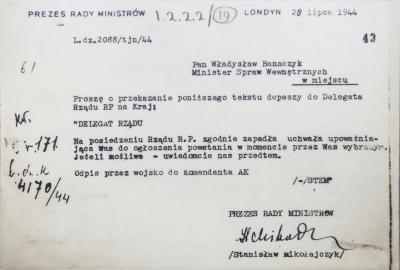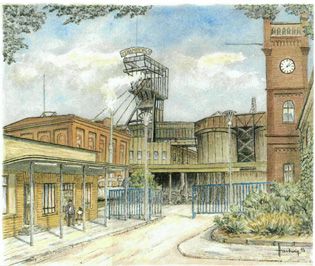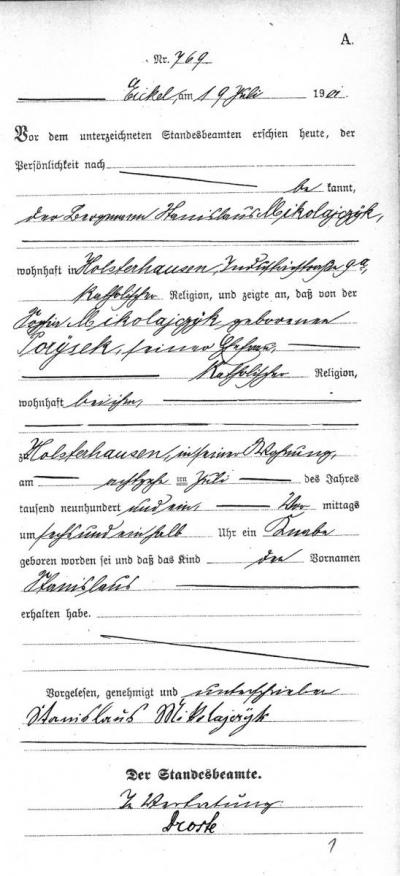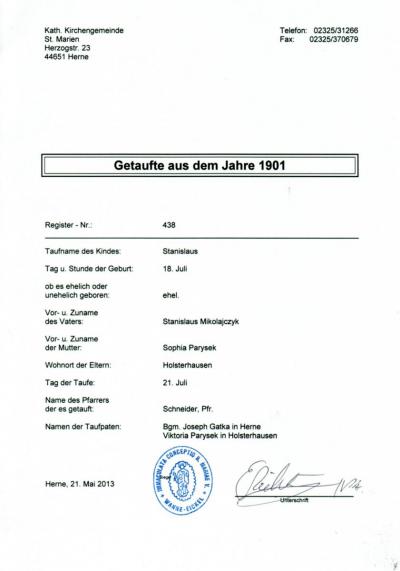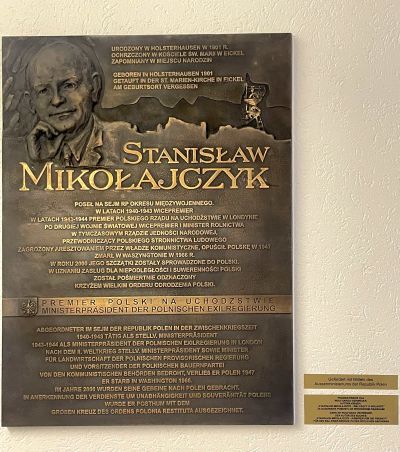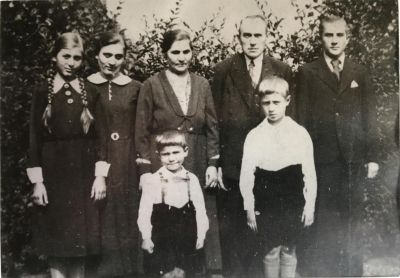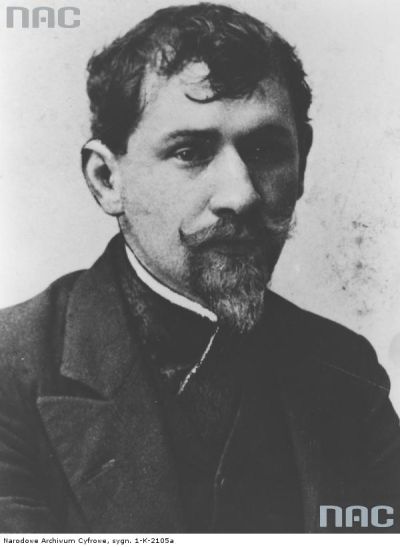Stanisław Mikołajczyk
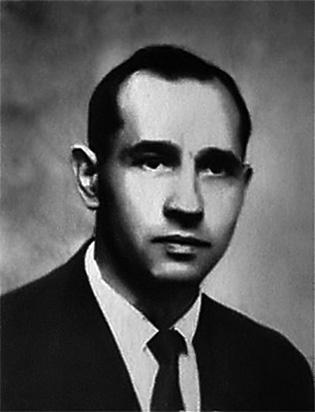
Although Stanisław Mikołajczyk was the Minister President of the Polish exile government between July 1943 and November 1944, there are next to no details about his childhood in the Ruhrgebiet. At the start of his memoirs, which were published in 1948 in Washington, he notes: “My father, who had 15 siblings, was born on a small farming estate in western Poland. He left the area to seek work in the coal mines of western Germany.” Mikołajczyk’s reticence is understandable because he wanted to protect friends and relatives in Poland because in 1948 the country had just become a Soviet-style “Peoples Republic”.
In biographies and on the Internet Mikołajczyk’s place of birth is given as “Holsterhausen in Westphalia“. This is correct but it is also confusing because the place name occurs not only in Essen and Dorsten but also in the former administrative district of Eickel. To date the favoured interpretation is Dorsten-Holsterhausen. The only clear reason for this is because the entries in the registers of births and baptisms have not been examined carefully enough. Historians have clearly not reckoned with the unprepossessing Holsterhausen; in 1809 it was still a hamlet with 147 inhabitants; and in 1902 it was at least a parish of 7289 inhabitants in the administrative district of Eickel. The result of this confusion had a disastrous effect on his reputation. The most famous Pole in the Ruhrgebiet during the 20th century was completely unknown not only in the region but also in his place of birth. And so he was never given the recognition due to him in the history of Poles in Germany.
The documents belonging to the registry office in Eickel (now kept in the Herne town archive), and the notes in the secretariat of the church of St Mary in Eickel in 1901 provide us with the following picture of the Mikołajczyk family in the Eickel district of Holsterhausen:
Around 1895 Stanisław Kostka Mikołajczyk, (the son of a farmer in the village of Benice in the district of Krotoschin in the Prussian province of Poznan) and his wife Sophia (maiden name, Parysek) left home to find work in the Eickel district of Holsterhausen. Here Stanisław Kostka was employed at the Shamrock I/II colliery. Around 1900 there were around 8,500 coalminers living in their own homes in the Herne mining area, the majority of whom lived in standardised colliery houses. Each household had five rooms covering a total of 81.5 m² on two floors. The rent was on average 15 to 20 marks a month, around half of the usual price on the free market. As a colliery face worker at Shamrock I/II, (after the turn-of-the-century at Shamrock III/IV), Stanisław Kostka earned 130 marks a month.
His son “Stanislaus“ was born on Thursday, 18th July 1901 at his home in Industriestraße 9a (now Beckumer Straße 9a) in Holsterhausen. On the following day his father registered the birth in the registry office in Eickel. The Registry officer Stork noted in sheet A 769 that the baby was a boy, born in wedlock and Roman Catholic. He was given the name “Stanislaus“. At the time registry officers were duty bound to enter first names with the final German syllable “-laus” instead of the final Polish syllable “-lav”. This regulation was introduced in 1890 by Kaiser Wilhelm II as part of his policies with regard to ethnic minorities. By contrast with his predecessors he was no longer prepared to tolerate the individual cultural features of minorities in the Reich, and wanted to wipe out any differences between minorities and German citizens, a policy which led precisely to nationality conflicts.
On Sunday 21st July 1901 the baby Stanislaus was baptised by the Catholic priest Josef Schneider in the church of St Mary in Eickel (registry number 438). His godparents were his mother’s sister, Viktoria Parysek, and a colleague of his father, a miner by the name of Joseph Gatka.
The family’s plans were ruined when the father suffered a heavy accident at work in 1907, following which he could only be employed as a surface worker. In 1908 his wife returned to Benice with her son who had just turned seven, and used her savings to purchase a six hectare farm in Striesen (Strzyżewo) in the rural district of Gnesen (Gniezno). Her husband remained in Holsterhausen until 1912 where he completed a training as a locksmith.
After finishing school young Stanisłav worked alternatively on his family’s farm and in a neighbouring sugar beet factory where he got to know some members of the National Polish association known as the “Falcons” (Sokół) and joined their group. On 20th June 1919 Poland became an independent country following the signing of the Treaty of Versailles. In August 1920 Mikołajczyk volunteered for service in the army of the Polish Marshall Piłsudski. Here they fought off the oncoming Red Army on the River Weichsel and pushed back the Soviets, who regarded Poland as “a renegade Russian province”, to the east. In the Peace of Riga the eastern borders of Poland were recognised by the Soviet Union on 18th March 1921.
Stanisław Mikołajczyk was wounded during battle and released from the army. He returned to the farm in Striesen and expanded it from 6 to 20 hectares. In the following years he attended agricultural courses at the adult educational centre in Gnesen. In 1924 he became the Secretary of the Farmers Party (Polskie Stronnictwo Ludowe PSL) in Poznan, edited a journal for farmers and tenants, and struggled politically against Marshall Piłsudski, who had set up a military dictatorship in Poland in 1926. In 1924 he married his youthful sweetheart Cecylia Ignasiak, and in 1926 his son Marian was born. Up until then his career had proceeded sharply upwards. In 1930 he entered the Sejm as a Member of Parliament for the Farmers Party in the constituency of Gnesen. He was helped by the fact of being a successful farmer, having considerable agronomic knowledge, being a talented orator, and on account of his fame as a war hero and his good looks.
On 27th August 1939 Mikołajczyk signed up as a private in a unit in West Poland and took part in trying to defend Poland against the German invasion of 1st September 1939. After defeat he fled to Paris via Hungary, Yugoslavia and Italy. Here he became a member of the Polish Government in exile but after the capitulation of France in 1940 it moved to London in order to organise military units of Polish exiles in the West. On 27th January 1940 Mikołajczyk was named the Minister of the Interior in the exile government. In the company of General Sikorsky (the Minister President of the Polish exile government) he visited Canada and the USA, and in December 1941, Moscow. There they signed an agreement with Stalin to fight against Hitler’s imperialism. On 22nd January 1942 Mikołajczyk was named as deputy Minister President on account of his diplomatic and organisational services to the exile government.
After advancing German troops discovered the mass graves of executed Polish officers in the Forest of Katyń near Smolensk in April 1943 General Sikorski requested the Red Cross in Switzerland to conduct an independent enquiry. Stalin used this request as an excuse to break off relationships with the Polish exile government on 25th April 1943. The exile government was now increasingly isolated because of the reticence of the Western allies to clarify who was guilty of the massacre. Their allies in Moscow were more important to them than the wishes of their allies in London.
After the death of General Sikorski on 14th July 1943 in a plane crash near Gibraltar, Mikołajczyk was named as his successor. At this point in time Stalin had already set up a “Polish Government” consisting of communists. His intention was to prepare it for playing a future role as a Soviet ally after the Red Army had liberated Poland. In July 1944 the Western powers tried to set up talks between Mikołajczyk and Stalin with the aim of getting them to agree on a coalition government of Polish exiles and communists. Stalin agreed to a coalition under Communist leadership and this was agreed to on 7th April 1944 by Mikołajczyk who had travelled with a delegation to Moscow.
On 24th November 1944 Mikołajczyk resigned from his office after realising that the military and political struggle of Polish exiles for a free Poland at the side of the Western powers had failed. On 16th June 1945 he travelled to Moscow where Stalin gave him a written pledge that the Red Army would move out of a sovereign Poland as soon as the situation allowed. Mikołajczyk became deputy Minister President and Minister of Agriculture in the provisional 19-seat government in Warsaw. On 5th July 1945 the victorious powers recognised the new government and broke off diplomatic relationships with the Polish exile government in London.
Mikołajczyk set up the Farmers Party once again and when they refused to enter a “block” with the Communists he and other members of the opposition were threatened with severe reprisals. The upshot was that he gave up his seat in the Sejm on the 8th October 1947. According to his memoirs he had also heard that he had already been condemned to death by a military tribunal. On 20th October 1947 he fled by rail from Warsaw via the province of Poznan and the Soviet occupation zone to the River Elbe from where he travelled north-west into the British zone. Here he was taken to London in a military aeroplane. The Polish exile government in London considered him to be a “traitor” because he had agreed to a coalition with the Communists and refused to recognise that to all extents and purposes Mikołajczyk had been following the same aim as they had.
Continuous hostile attitudes made it impossible for Mikołajczyk and his family to remain in London and so they left for the USA on board the “Queen Elizabeth” in mid August 1948. Once they arrived they moved into their own house in a district of Washington. Cecylia Mikołajczyk, who had survived the concentration camps in Majdanek, Auschwitz and Ravensbrück died in 1951 from the after-effects of her imprisonment. Their son Marian found a job in an American aircraft business. Stanisław Mikołajczyk was elected Chair of the International Farmers Union by emigrants from Poland and other Eastern countries. He died on 13th December 1966 in Washington. In June 2000 he was recognised as a victim of Stalin by the Polish government in Warsaw and rehabilitated. His mortal remains were then flown to Poland and laid to rest in Poznan.
Wolfgang Viehweger, February 2015
Addendum by the editors:
On 18 October 2015, a commemorative plaque for Stanisław Mikołajczyk donated by the Polish Ministry of Foreign Affairs was unveiled in the entrance to the parish hall of St Mary's Church in Eickel during a memorial service (see picture). In course of the ceremony, the grave of Prelate Josef Schneider, who had baptised Mikołajczyk in 1901, as well as the original baptismal font in St Mary's Church were visited in the presence of Wolfgang Viehweger, the author of this article, Consul General Jan Sobczak and the artist Jerzy Bokrzycki from Wrocław.
Further reading:
Gmitruk, Janusz: Stanisław Mikołajczyk: trudny powrót. Muzeum Historii Polskiego Ruchu Ludowego, Warszawa 2002
Paczkowski, Andrzej: Stanislaw Mikołajczyk, czyli kleska realisty. Warszawa 1991
Viehweger, Wolfgang: Stanislaw Mikolajczyk – Kämpfer für die Freiheit. Herne 2014
Mikołajczyk’s memoirs were serialised in Der Spiegel in 1948 http://www.spiegel.de/spiegel/print/d-44415220.html
Documents on Mikołajczyk can be found in the Hoover Institution Archives at Stanford University Search under: http://www.oac.cdlib.org/institutions/Hoover+Institution
